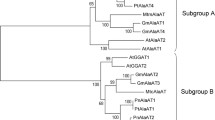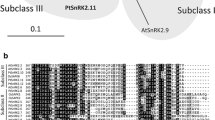Abstract
To understand the function of phosphoenolpyruvate carboxylase kinase, we introduced PtPEPCK1 gene under the control of 35S promoter into 84K poplar (Populus alba × P. glandulosa). PtPEPCK1 gene is well-known for its role in gluconeogenesis. However, our data confirmed that it has significant effects on amino acid biosynthesis and nitrogen metabolism. Immunohistochemistry and fluorescence microscopy indicate that PtPEPCK1 is specifically expressed in the cytoplasm of the spongy and palisade tissues. Overexpression of PtPEPCK1 was characterized through transcriptomics and metabolomics. The metabolites concentration of the ornithine cycle and its precursors also increased, of which N-acetylornithine was up-regulated almost 50-fold and ornithine 33.7-fold. These were accompanied by a massive increase in levels of several amino acids. Therefore, overexpression of PtPEPCK1 increases amino acid levels with urea cycle disorder.










Similar content being viewed by others
Change history
17 September 2022
A Correction to this paper has been published: https://doi.org/10.1007/s11676-022-01536-8
References
Azevedo RA, Arruda P, Turner WL, Peter JL (1998) ChemInform abstract: biosynthesis and metabolism of the aspartate-derived amino acids in higher plants. Cheminform 29(2):395–419
Bahrami AR, Chen ZH, Walker RP, Leegood R, Gray JE (2001) Ripening-related occurrence of phosphoenolpyruvate carboxykinase in tomato fruit[J]. Plant Mol Biol 47(4):499–506
Balint T, Rengel Z (2011) Amino acid composition of xylem and phloem sap varies in canola genotypes differing in nitrogen- and sulfur-use efficiency. Crop Pasture Sci 62(3):198–207
Chao YP, Liao JC (1994) Metabolic responses to substrate futile cycling in Escherichia coli. J Biol Chem 269(7):5122–5126
Chen ZH, Walker RP, Acheson R, Técsi LI, Wingler A, Lea PJ, Leegood R (2000) Are isocitrate lyase and phosphoenolpyruvate carboxykinase involved in gluconeogenesis during senescence of barley leaves and cucumber cotyledons? Plant Cell Physiol 41(8):960–967
Chen ZH, Walker RP, Acheson RM, Leegood RC (2002) Phosphoenolpyruvate carboxykinase assayed at physiological concentrations of metal ions has a high affinity for CO2. Plant Physiol 128(1):160–164
Choi DS, Kim NH, Hwang BK (2015) The pepper phosphoenolpyruvate carboxykinase capepck1 is involved in plant immunity against bacterial and oomycete pathogens. Plant Mol Biol 89(1–2):99–111
Christian OB, Alexander S (2002) The malate dehydrogenase of ralstonia eutropha and functionality of the C3/C4 metabolism in a Tn5-induced mdh mutant. FEMS Microbiol Lett 212(2):159–164
Confalonieri M, Balestrazzi A, Bisoffi S (1994) Genetic transformation of Populus nigra by Agrobacterium tumefaciens. Plant Cell Rep 13(5):256–261
Delgado-Alvarado A, Walker RP, Leegood RC (2010) Phosphoenolpyruvate carboxykinase in developing pea seeds is associated with tissues involved in solute transport and is nitrogen-responsive. Plant, Cell Environ 30(2):225–235
Du SC, Kim NH, Hwang BK (2015) The pepper phosphoenolpyruvate carboxykinase CaPEPCK1 is involved in plant immunity against bacterial and oomycete pathogens. Plant Mol Biol 89(1–2):99–111
Edwards GE, Kanai R, Black CC (1971) Phosphoenolpyruvate carboxykinase in leaves of certain plants which fix CO2 by the C4-dicarboxylic acid cycle of photosynthesis. Biochem Biophys Res Commun 45(2):278–285
Famiani F, Paoletti A, Proietti P, Battistelli A, Moscatello S (2018) The occurrence of phosphoenolpyruvate carboxykinase (PEPCK) in the pericarp of different grapevine genotypes and in grape leaves and developing seeds. J Hortic Sci Biotechnol 23:1–10
Felice BD, Manfellotto F, Raffaella D, Olga DC, Antonietta DM, Marco T (2013) Comparative transcriptional analysis reveals differential gene expression between Sand Daffodil tissues. Genetica 141(10–12):443–452
Habash DZ, Bernard SM (2009) The importance of cytosolic glutamine synthetase in nitrogen assimilation and recycling. New Phytol 182(3):608–620
Hu YB, Bellaloui N, Sun GY, Tigabu M, Wang JH (2014) Exogenous sodium sulfide improves morphological and physiological responses of a hybrid Populus species to nitrogen dioxide. J Plant Physiol 171(10):868–875
Huang YX, Yin YG, Sanuki A, Fukuda N, Ezura H, Matsukura C (2015) Phosphoenolpyruvate carboxykinase (PEPCK) deficiency affects the germination, growth and fruit sugar content in tomato (Solanum lycopersicum L.). Plant Physiol Biochem 96:417–425
Hussain SS, Kayani MA, Amjad M (2011) Transcription factors as tools to engineer enhanced drought stress tolerance in plants. Biotechnol Prog 27(2):297–306
Jiang F, Chen XP, Hu WS, Zheng SQ (2016) Identification of differentially expressed genes implicated in peel color (red and green) of Dimocarpus confinis. SpringerPlus 5(1):1088
Lea PJ, Chen ZH, Leegood R, Walker RP (2001) Does phosphoenolpyruvate carboxykinase have a role in both amino acid and carbohydrate metabolism? Amino Acids 20(3):225–241
Leegood RC, Ap RT (1978) Identification of the regulatory steps in gluconeogenesis in cotyledons of Cucurbita pepo. Biochim Biophys Acta 524(1):1–11
Leegood RC, Walker RP (2003) Regulation and roles of phosphoenolpyruvate carboxykinase in plants. Arch Biochem Biophys 414(2):204–210
Li TQ, Liu XF, Wan YM, Li ZH, Qi GH, Li YY, Liu XX, He R, Ma Y, Ma H (2017) Transcriptome analysis for (plant species with extremely small populations) based on high throughput sequencing. Bull Bot Res 37(6):825–834
Liu KY, Ba XL, Yu JZ, Li J, Wei KQ, Han GD, Li GP, Cui Y (2006) The phosphoenolpyruvate carboxykinase of mycobacterium tuberculosis, induces strong cell-mediated immune responses in mice. Mol Cell Biochem 288(1–2):65–71
Maciaga M, Paszkowski A (2004) Genetic control of aspartate aminotransferase isoenzymes in Aegilops and Triticum species. J Appl Genet 45(4):411–417
Majumdar R, Minocha R, Minocha SC, D’Mello JPF (2015) Ornithine: at the crossroads of multiple paths to amino acids and polyamines. CAB International, pp 156–172
Manzoor H, Kelloniemi J, Chiltz A, Wendehenne D, Alain P, Poinssot B, Garcia-Brugger A (2013) Involvement of the glutamate receptor atglr3.3 in plant defense signaling and resistance to hyaloperonospora arabidopsidis. Plant J 76(3):466–480
Martín M, Rius SP, Podestá FE (2011) Two phosphoenolpyruvate carboxykinases coexist in the crassulacean acid metabolism plant Ananas comosus. Isolation and characterization of the smaller 65 kDa form. Plant Physiol Biochem 49(6):646–653
Mattoo AK, Fatima T, Upadhyay RK, Handa AK (2015) Polyamines in plants: biosynthesis from arginine, and metabolic, physiological and stress-response roles. In: D’Mello JPF (ed) Amino acids in higher plants. CAB International, Wallingford, pp 177–194
Meijer AJ, Lamers WH, Chamuleau RA (1990) Nitrogen metabolism and ornithine cycle function. Physiol Rev 70(3):701–748
Movahedi A, Zhang J, Amirian R, Zhuge Q (2014) An efficient agrobacterium-mediated transformation system for poplar. Int J Mol Sci 15(6):10780–10793
Murooka Y, Mori Y, Hayashi M (2002) Variation of the amino acid content of Arabidopsis seeds by expressing soybean aspartate aminotransferase gene. J Biosci Bioeng 94(3):225–230
Nakagawa T, Kurose T, Hino T, Tanaka K, Kawamukai M, Niwa Y, Toyooka K, Matsuoka K, Jinbo T, Kimura T (2007) Development of series of gateway binary vectors, pGWBs, for realizing efficient construction of fusion genes for plant transformation. J Biosci Bioeng 104(1):34–41
Osorio S, Vallarino JG, Szecowka M, Ufaz S, Tzin V, Angelovici R, Gad G, Fernie RA (2013) Alteration of the interconversion of pyruvate and malate in the plastid or cytosol of ripening tomato fruit invokes diverse consequences on sugar but similar effects on cellular organic acid, metabolism, and transitory starch accumulation. Plant Physiol 161(2):628–643
Owen OE, Kalhan SC, Hanson RW (2002) The key role of anaplerosis and cataplerosis for citric acid cycle function. J Biol Chem 277(34):30409–30412
Pilot G, Stransky H, Bushey DF, Pratelli R, Ludewig U, Wingate VP, Frommer WB (2004) Overexpression of glutamine dumper1 leads to hypersecretion of glutamine from hydathodes of arabidopsis leaves. Plant Cell 16(7):1827–1840
Pinto H, Sharwood RE, Tissue DT, Ghannoum O (2014) Photosynthesis of C3, C3–C4, and C4 grasses at glacial CO2. J Exp Bot 65(13):3669–3681
Price MB, Kong D, Okumoto S (2013) Inter-subunit interactions between glutamate-like receptors in Arabidopsis. Plant Signal Behav 8(12):e27034
Roosens NH, Bitar FA, Loenders K, Angenon G, Jacobs M (2002) Overexpression of ornithine-δ-aminotransferase increases proline biosynthesis and confers osmotolerance in transgenic plants. Mol Breeding 9(2):73–80
Shi JH, Yi KK, Yu L, Li X, Zhou ZJ, Chen Y, Hu ZH, Tao Z, Liu RH, Chen YL, Chen JQ (2015) Phosphoenolpyruvate carboxylase in Arabidopsis leaves plays a crucial role in carbon and nitrogen metabolism. Plant Physiol 167(3):671–681
Sun Su (2018) Functional analysis of photosynthesis by transgenic maize ZmPCK1 gene. Jilin Agric Univ 1(1):11–13
Urbina JA, Osorno CE, Rojas A (1990) Inhibition of phosphoenolpyruvate carboxykinase from Trypanosoma (Schizotrypanum) cruzi epimastigotes by 3-mercaptopicolinic acid: in vitro and in vivo studies. Arch Biochem Biophys 282(1):91–99
Walker RP, Chen ZH (2002) Phosphoenolpyruvate carboxykinase: structure, function and regulation. Adv Bot Res 38(02):93–189
Walker RP, Leegood R (1996) Phosphorylation of phosphoenolpyruvate carboxykinase in plants. Studies in plants with C4 photosynthesis and Crassulacean acid metabolism and in germinating seeds. Biochem J 317(3):653–658
Walker R, Tecsi L, Famiani FP, Leegood R, Chen Z (1999) Phosphoenolpyruvate carboxykinase plays a role in interactions of carbon and nitrogen metabolism during grape seed development. Planta 210(1):9–18
Walker RP, Benincasa P, Battistelli A, Moscatello S, Técsi L, Leegood RC, Famiani F (2018) Gluconeogenesis and nitrogen metabolism in maize. Plant Physiol Biochem 130:324–333
Wang JY (2011) Amino acid metabolism. Biochemistry 31:340–341
Wang LN, Wang YC, Yang CP (2017) The comparative study of callus and direct differentiation regeneration system of 84K poplar. Bull Bot Res 37(4):542–548
Wingler A (1999) Phosphoenolpyruvate carboxykinase is involved in the decarboxylation of aspartate in the bundle sheath of maize. Plant Physiol 120(2):539–546
Yu ZH (2012) Research and application of HPCE-TOF/MS technology in the analysis of common toxic alkaloids. Doctoral dissertation, Fudan University, pp 8–11
Zeng J, Kuang H, Hu C, Shi X, Yan M, Xu L, Xu GW (2013) Effect of bisphenol a on rat metabolic profiling studied by using capillary electrophoresis time-of-flight mass spectrometry. Environ Sci Technol 47(13):7457–7465
Zhao JX (2016) A new method based on CE-MS for metabolomics analysis and its application in tobacco research. Doctoral dissertation, Dalian University of Technology, pp 43–45
Author information
Authors and Affiliations
Corresponding author
Additional information
Publisher's Note
Springer Nature remains neutral with regard to jurisdictional claims in published maps and institutional affiliations.
Project funding: This work was supported by the grants from the National Natural Science Foundation of China (No. 3180030530), and the Fundamental Research Funds for the Central Universities (2572019BA14).
The online version is available at http://www.springerlink.com
Corresponding editor: Yanbo Hu.
Electronic supplementary material
Below is the link to the electronic supplementary material.
Rights and permissions
Springer Nature or its licensor holds exclusive rights to this article under a publishing agreement with the author(s) or other rightsholder(s); author self-archiving of the accepted manuscript version of this article is solely governed by the terms of such publishing agreement and applicable law.
About this article
Cite this article
Wang, L., He, M., Chen, S. et al. Overexpression of PtPEPCK1 gene promotes nitrogen metabolism in poplar. J. For. Res. 30, 2289–2303 (2019). https://doi.org/10.1007/s11676-019-01042-4
Received:
Accepted:
Published:
Issue Date:
DOI: https://doi.org/10.1007/s11676-019-01042-4




